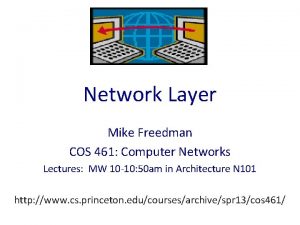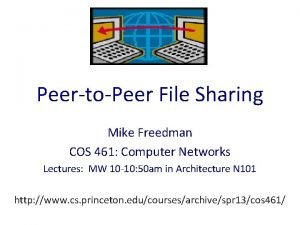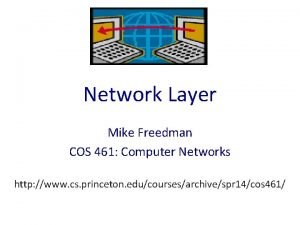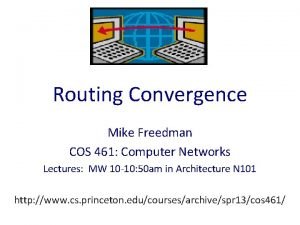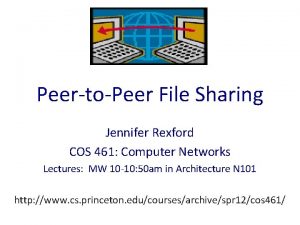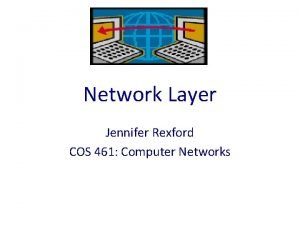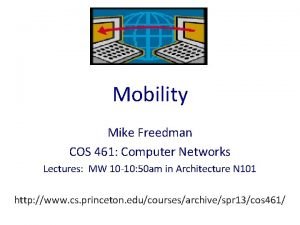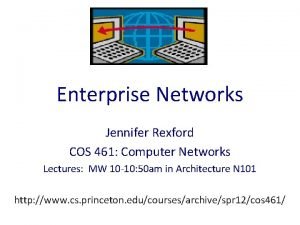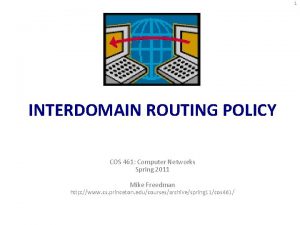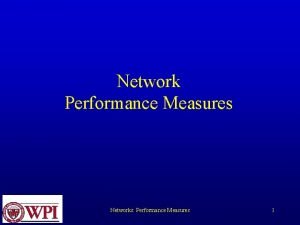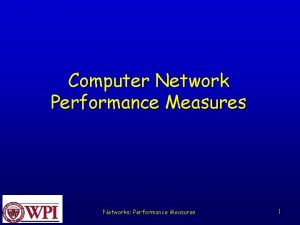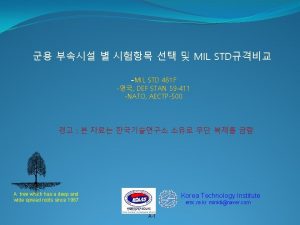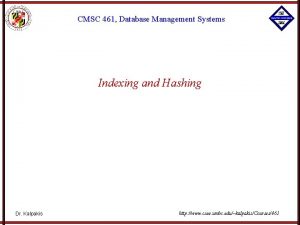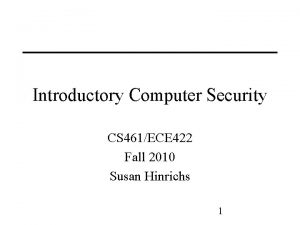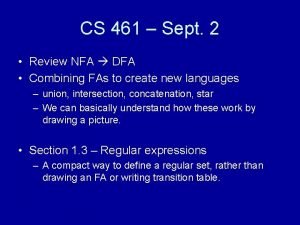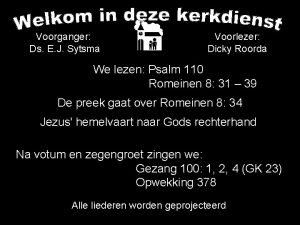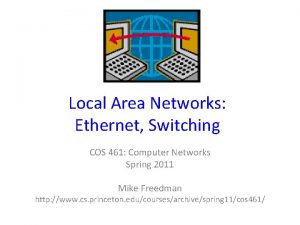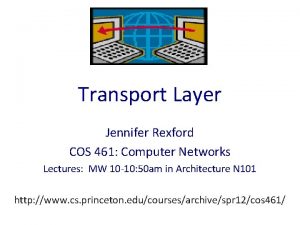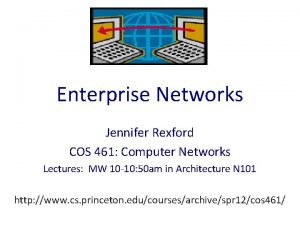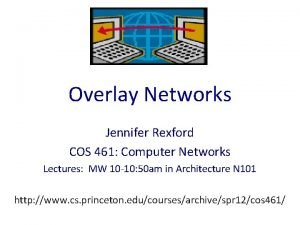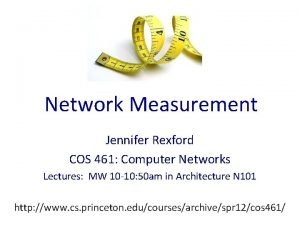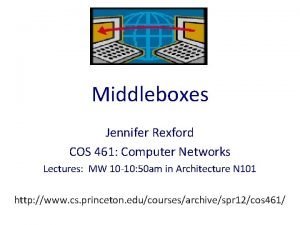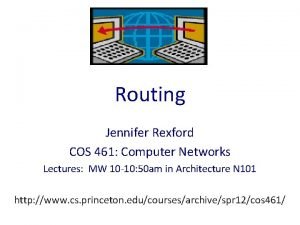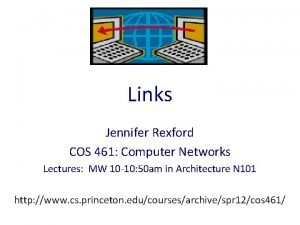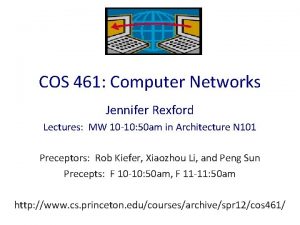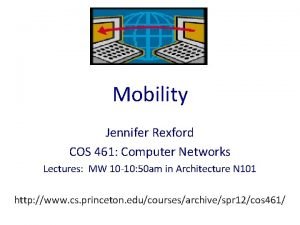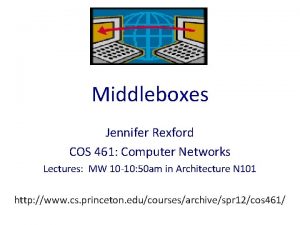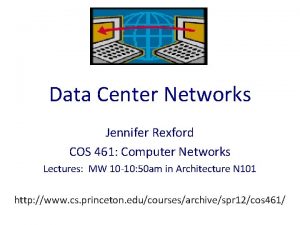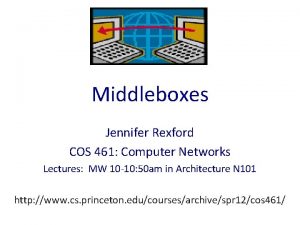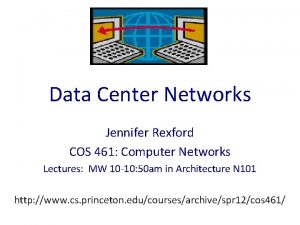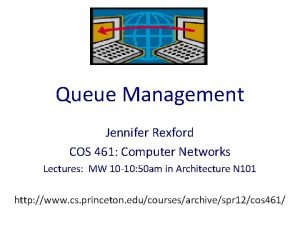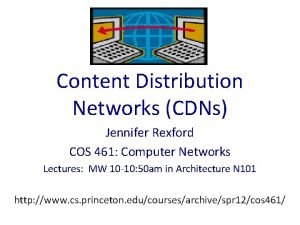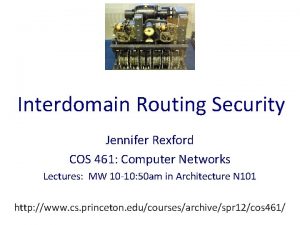Network Layer Jennifer Rexford COS 461 Computer Networks













































- Slides: 45

Network Layer Jennifer Rexford COS 461: Computer Networks Lectures: MW 10 -10: 50 am in Architecture N 101 http: //www. cs. princeton. edu/courses/archive/spr 12/cos 461/

IP Protocol Stack: Key Abstractions Application Transport Network Link Applications Reliable streams Messages Best-effort global packet delivery Best-effort local packet delivery 2

Best-Effort Global Packet Delivery 3

Circuit Switching • Source establishes connection – Reserve resources along hops in the path • Source sends data – Transmit data over the established connection • Source tears down connection – Free the resources for future connections 4

Circuit Switching: Static Allocation – Each circuit allocated certain time slots time • Frequency-division – Each circuit allocated certain frequencies frequency • Time-division time 5

Circuit Switching: Pros and Cons • Advantages – Predictable performance – Reliable, in-order delivery – Simple forwarding – No overhead for packet headers • Disadvantages – Wasted bandwidth – Blocked connections – Connection set-up delay – Per-connection state inside the network 6

Packet Switching • Message divided into packets – Header identifies the destination address • Packets travel separately through the network – Forwarding based on the destination address – Packets may be buffered temporarily • Destination reconstructs the message 7

Packet Switching: Statistical Multiplexing • Data traffic is bursty – Telnet, email, Web browsing, … • Avoid wasting bandwidth – One host can send more when others are idle 8

Best Effort • Best-effort delivery – Packets may be lost – Packets may be corrupted – Packets may be delivered out of order source destination IP network 9

Best Effort: Celebrating Simplicity • Never having to say you’re sorry… – Don’t reserve bandwidth and memory – Don’t do error detection and correction – Don’t remember from one packet to next • Easier to survive failures – Transient disruptions are okay during failover • Easier to support on many kinds of links – Important for interconnecting different networks 10

Best-Effort: Good Enough? • Packet loss and delay – Sender can resend • Packet corruption – Receiver can detect, and sender can resend • Out-of-order delivery – Receiver can put the data back in order • Packets follow different paths – Doesn’t matter • Network failure – Drop the packet • Network congestion – Drop the packet 11

Network Addresses 12

IP Address (IPv 4) • A unique 32 -bit number • Identifies an interface (on a host, on a router, …) • Represented in dotted-quad notation 12 34 158 5 00001100 0010 10011110 00000101 13

Grouping Related Hosts • The Internet is an “inter-network” – Used to connect networks together, not hosts – Need to address a network (i. e. , group of hosts) host. . . host. . . LAN 2 LAN 1 router WAN LAN = Local Area Network WAN = Wide Area Network 14 host router WAN router

Scalability Challenge • Suppose hosts had arbitrary addresses – Then every router would need a lot of information – …to know how to direct packets toward every host 1. 2. 3. 4 5. 6. 7. 8 host. . . 2. 4. 6. 8 1. 2. 3. 5 5. 6. 7. 9 host. . . host LAN 2 LAN 1 router WAN 1. 2. 3. 4 1. 2. 3. 5 15 2. 4. 6. 9 forwarding table router

Hierarchical Addressing in U. S. Mail • Addressing in the U. S. mail – Zip code: 08540 – Building: 35 Olden Street – Room in building: 306 – Name of occupant: Jennifer Rexford ? ? ? • Forwarding the U. S. mail – Deliver to the post office in the zip code – Assign to mailman covering the building – Drop letter into mailbox for building/room – Give letter to the appropriate person 16

Hierarchical Addressing: IP Prefixes • Network and host portions (left and right) • 12. 34. 158. 0/24 is a 24 -bit prefix with 28 addresses 12 34 158 5 00001100 0010 10011110 00000101 Network (24 bits) 17 Host (8 bits)

IP Address and 24 -bit Subnet Mask Address 12 34 158 5 00001100 0010 10011110 00000101 11111111 0000 Mask 255 255 0 18

Scalability Improved • Number related hosts from a common subnet – 1. 2. 3. 0/24 on the left LAN – 5. 6. 7. 0/24 on the right LAN 1. 2. 3. 4 1. 2. 3. 7 1. 2. 3. 156 host. . . 5. 6. 7. 8 5. 6. 7. 9 5. 6. 7. 212 host. . . LAN 2 LAN 1 router WAN 1. 2. 3. 0/24 5. 6. 7. 0/24 forwarding table 19 host router

Easy to Add New Hosts • No need to update the routers – E. g. , adding a new host 5. 6. 7. 213 on the right – Doesn’t require adding a new forwarding-table entry 1. 2. 3. 4 1. 2. 3. 7 1. 2. 3. 156 host. . . 5. 6. 7. 8 5. 6. 7. 9 5. 6. 7. 212 host. . . host LAN 2 LAN 1 router WAN router host 5. 6. 7. 213 1. 2. 3. 0/24 5. 6. 7. 0/24 forwarding table 20

History of IP Address Allocation 21

Classful Addressing • In the olden days, only fixed allocation sizes – Class A: 0* • Very large /8 blocks (e. g. , MIT has 18. 0. 0. 0/8) – Class B: 10* • Large /16 blocks (e. g, . Princeton has 128. 112. 0. 0/16) – Class C: 110* • Small /24 blocks (e. g. , AT&T Labs has 192. 20. 225. 0/24) – Class D: 1110* for multicast groups – Class E: 11110* reserved for future use • This is why folks use dotted-quad notation! 22

Classless Inter-Domain Routing (CIDR) Use two 32 -bit numbers to represent a network. Network number = IP address + Mask IP Address : 12. 4. 0. 0 Address Mask IP Mask: 255. 254. 0. 0 00001100 00000000 11111110 00000000 Network Prefix for hosts Written as 12. 4. 0. 0/15 23

Hierarchical Address Allocation • Hierarchy is key to scalability – Address allocated in contiguous chunks (prefixes) – Today, the Internet has about 400, 000 prefixes 12. 0. 0. 0/16 12. 1. 0. 0/16 12. 2. 0. 0/16 12. 3. 0. 0/16 12. 0. 0. 0/8 : : : 12. 254. 0. 0/16 12. 3. 0. 0/24 12. 3. 1. 0/24 : : : 12. 3. 254. 0/24 12. 253. 0. 0/19 12. 253. 32. 0/19 : : 12. 253. 160. 0/19 24

Obtaining a Block of Addresses • Internet Corporation for Assigned Names and Numbers (ICANN) – Allocates large blocks to Regional Internet Registries • Regional Internet Registries (RIRs) – E. g. , ARIN (American Registry for Internet Numbers) – Allocates to ISPs and large institutions • Internet Service Providers (ISPs) – Allocate address blocks to their customers – Who may, in turn, allocate to their customers… 25

Pre-CIDR (1988 -1994): Steep Growth faster than improvements in equipment capability 26

CIDR (1994 -1996): Much Flatter Efforts to aggregate 27

CIDR Growth (1996 -1998): Roughly Linear Good use of aggregation, and peer pressure! 28

Dot. Com Boom (1998 -2001): Steep Growth Internet boom and increased multi-homing 29

Long Term (1989 -2005): Post-Boom Today we are up to ~400, 000 prefixes 30

Packet Forwarding 31

IP Router control plane data plane Processor Adapter 32 Adapter Switching Fabric Adapter

Hop-by-Hop Packet Forwarding • Each router has a forwarding table – Maps destination address to outgoing interface • Upon receiving a packet – Inspect the destination address in the header – Index into the table – Determine the outgoing interface – Forward the packet out that interface • Then, the next router in the path repeats 33

Separate Forwarding Entry Per Prefix • Prefix-based forwarding – Map the destination address to matching prefix – Forward to the outgoing interface 1. 2. 3. 4 1. 2. 3. 7 1. 2. 3. 156 host. . . 5. 6. 7. 8 5. 6. 7. 9 5. 6. 7. 212 host. . . LAN 1 router WAN 1. 2. 3. 0/24 5. 6. 7. 0/24 forwarding table 34 host router WAN router

CIDR Makes Packet Forwarding Harder • Forwarding table may have many matches – E. g. , entries for 201. 10. 0. 0/21 and 201. 10. 6. 0/23 – The IP address 201. 10. 6. 17 would match both! 201. 10. 0. 0/21 Provider 1 201. 10. 0. 0/22 201. 10. 4. 0/24 201. 10. 5. 0/24 201. 10. 6. 0/23 35 Provider 2

Longest Prefix Match Forwarding • Destination-based forwarding – Packet has a destination address – Router identifies longest-matching prefix – Cute algorithmic problem: very fast lookups forwarding table destination 201. 10. 6. 17 36 4. 0. 0. 0/8 4. 83. 128. 0/17 201. 10. 0. 0/21 201. 10. 6. 0/23 126. 255. 103. 0/24 outgoing link Serial 0/0. 1

Creating a Forwarding Table • Entries can be statically configured – E. g. , “map 12. 34. 158. 0/24 to Serial 0/0. 1” • But, this doesn’t adapt – To failures – To new equipment – To the need to balance load • That is where the control plane comes in – Routing protocols 37

IP Packet Format 38

IP Packet Structure 4 -bit 8 -bit 4 -bit Version Header Type of Service Length (TOS) 3 -bit Flags 16 -bit Identification 8 -bit Time to Live (TTL) 16 -bit Total Length (Bytes) 8 -bit Protocol 13 -bit Fragment Offset 16 -bit Header Checksum 32 -bit Source IP Address 32 -bit Destination IP Address Options (if any) Payload

IP Header: Version, Length, To. S • Version number (4 bits) – Necessary to know what other fields to expect – Typically “ 4” (for IPv 4), and sometimes “ 6” (for IPv 6) • Header length (4 bits) – Number of 32 -bit words in the header – Typically “ 5” (for a 20 -byte IPv 4 header) – Can be more when “IP options” are used • Type-of-Service (8 bits) – Allow different packets to be treated differently – Low delay for audio, high bandwidth for bulk transfer 40

IP Header: Length, Fragments, TTL • Total length (16 bits) – Number of bytes in the packet – Max size is 63, 535 bytes (216 -1) – … though most links impose smaller limits • Fragmentation information (32 bits) – Supports dividing a large IP packet into fragments – … in case a link cannot handle a large IP packet • Time-To-Live (8 bits) – Used to identify packets stuck in forwarding loops – … and eventually discard them from the network 41

IP Header: Transport Protocol • Protocol (8 bits) – Identifies the higher-level protocol • E. g. , “ 6” for the Transmission Control Protocol (TCP) • E. g. , “ 17” for the User Datagram Protocol (UDP) – Important for demultiplexing at receiving host • Indicates what kind of header to expect next protocol=6 protocol=17 IP header TCP header UDP header 42

IP Header: Header Checksum • Checksum (16 bits) – Sum of all 16 -bit words in the header – If header bits are corrupted, checksum won’t match – Receiving discards corrupted packets 134 + 212 Mismatch! 134 + 216 = 346 = 350 43

IP Header: To and From Addresses • Destination IP address (32 bits) – Unique identifier for the receiving host – Allows each node to make forwarding decisions • Source IP address (32 bits) – Unique identifier for the sending host – Recipient can decide whether to accept packet – Enables recipient to send a reply back to source 44

Conclusion • Best-effort global packet delivery – Simple end-to-end abstraction – Enables higher-level abstractions on top – Doesn’t rely on much from the links below • IP addressing and forwarding – Hierarchy for scalability and decentralized control – Allocation of IP prefixes – Longest prefix match forwarding • Next time: transport layer 45
 Jennifer rexford
Jennifer rexford The network layer concerns with
The network layer concerns with Network layer design issues
Network layer design issues Cos 461
Cos 461 Cos 461
Cos 461 Cos 461
Cos 461 Cos 461
Cos 461 Cos 461
Cos 461 Cos 461
Cos 461 Cos 461
Cos 461 Cos 461
Cos 461 Precidr
Precidr Cos
Cos Puwifi
Puwifi Gao rexford conditions
Gao rexford conditions Datagram network
Datagram network Basestore iptv
Basestore iptv Data link layer switching in computer networks
Data link layer switching in computer networks Osi reference model ppt
Osi reference model ppt Elementary data link protocols
Elementary data link protocols Hdlc and ppp
Hdlc and ppp Principles of network applications
Principles of network applications Network performance measurement in computer networks
Network performance measurement in computer networks Network performance measurement
Network performance measurement Network performance measurement in computer networks
Network performance measurement in computer networks A link layer protocol for quantum networks
A link layer protocol for quantum networks Greedy layer wise training of deep networks
Greedy layer wise training of deep networks Types of network topology
Types of network topology Jerome freedman
Jerome freedman Mil-std-461g 한글 pdf
Mil-std-461g 한글 pdf Cmsc 461
Cmsc 461 Cs 461 uiuc
Cs 461 uiuc Cs 461
Cs 461 Ccna voice 640-461 pdf
Ccna voice 640-461 pdf Kkk 461
Kkk 461 Opwekking 461 tekst
Opwekking 461 tekst Mil std 461 464
Mil std 461 464 Icvm 461/07
Icvm 461/07 Area 461
Area 461 Ece 422 uiuc
Ece 422 uiuc What did st patrick chase out of ireland
What did st patrick chase out of ireland Opwekking 585
Opwekking 585 Contul 4427
Contul 4427 Fig 19
Fig 19 Brush border enzymes
Brush border enzymes Secure socket layer and transport layer security
Secure socket layer and transport layer security




